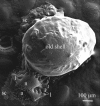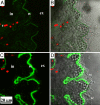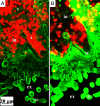The role of seawater endocytosis in the biomineralization process in calcareous foraminifera
- PMID: 20007770
- PMCID: PMC2799886
- DOI: 10.1073/pnas.0906636106
The role of seawater endocytosis in the biomineralization process in calcareous foraminifera
Abstract
Foraminifera are unicellular organisms that inhabit the oceans in various ecosystems. The majority of the foraminifera precipitate calcitic shells and are among the major CaCO(3) producers in the oceans. They comprise an important component of the global carbon cycle and also provide valuable paleoceanographic information based on the relative abundance of stable isotopes and trace elements (proxies) in their shells. Understanding the biomineralization processes in foraminifera is important for predicting their calcification response to ocean acidification and for reliable interpretation of the paleoceanographic proxies. Most models of biomineralization invoke the involvement of membrane ion transporters (channels and pumps) in the delivery of Ca(2+) and other ions to the calcification site. Here we show, in contrast, that in the benthic foraminiferan Amphistegina lobifera, (a shallow water species), transport of seawater via fluid phase endocytosis may account for most of the ions supplied to the calcification site. During their intracellular passage the seawater vacuoles undergo alkalization that elevates the CO(3)(2-) concentration and further enhances their calcifying potential. This mechanism of biomineralization may explain why many calcareous foraminifera can be good recorders of paleoceanographic conditions. It may also explain the sensitivity to ocean acidification that was observed in several planktonic and benthic species.
Conflict of interest statement
The authors declare no conflict of interest.
Figures







References
-
- Erez J. The source of ions for biomineralization in foraminifera and their implications for paleoceanographic proxies. Rev Mineral Geochem. 2003;54:115–149.
-
- Lowenstam HA, Weiner S. On Biomineralization. Oxford: Oxford Univ Press; 1989.
-
- Simkiss K, Wilbur K. Biomineralization. Cell Biology and Mineral Deposition. San Diego: Academic, Inc.; 1989.
-
- Marshall AT, Clode PL. Effect of increased calcium concentration in sea water on calcification and photosynthesis in the scleractinian coral Galaxea fascicularis. J Exp Biol. 2002;205:2107–2113. - PubMed
-
- Wheatly MG, Zanotto FP, Hubbard MG. Calcium homeostasis in crustaceans: Subcellular Ca dynamics. Comp Biochem Phys B. 2002;132:163–178. - PubMed
Publication types
MeSH terms
Substances
Grants and funding
LinkOut - more resources
Full Text Sources
Medical
Miscellaneous

